Abstract
This study is related to the development of a theoretical and methodological apparatus for the further economic and scientific-technological development of the economic system of the Russian Federation in the context of the introduction of the digital economy in various areas of economic activity. The relevance of the topic of research is associated with the implementation in Russia of the Program for the Development of the Digital Economy in Russia. Well-known economic subsystems, technological trends in digital transformation and their impact on the development of the economic system of the Russian Federation have been studied. Methods of scientific knowledge of the material, such as analysis, synthesis, deduction, etc., have been used. Statistical data of federal state statistical bodies characterizing the scientific and technological development of the production and economic system of the Russian Federation were analyzed. The author's classification of the development of the program on digitalization of the economy is presented. Technological trends in digital transformation of economic subsystems and trends of scientific and technological development of the economic system are considered. The areas of further research are related to the study of new management systems and markets outlined in the program for the development of the digital economy in the Russian Federation until 2035.
Keywords: Digitalization, economy, subsystem, management, institutional environment
Introduction
To ensure economic growth at present, it is not enough to simply develop industry, it is necessary to carry out an industrial revolution. The digital economy is an economy based on new methods of generating, processing, storing and transmitting data, as well as on digital computer technologies. There is no doubt that only those countries that will be able to provide a favorable environment for the development of the digital economy will set the pace in the world market.
Broadly speaking, digital economics is understood as a collection of economic, social and general technical relationships based on the use of digital technologies (Alexandrova et al., 2018).
The main factors determining the country's membership in a particular group of "digital development" are: the level of innovative development, the institutional environment, the level of supply and demand for digital technologies. Despite the fact that Russia is not yet distinguished by the high indicators of the above criteria, the country is developing and showing stable growth. The trend requires an integrated approach to the development of public policies aimed at the development of the digital economy in the country.
Many researchers associate medium-term trends in the development of society and the economy with their digitalization (Avdeeva et al., 2013; Bodrunov et al., 2018; Ivanovskaya, 2019; Kurbanov & Kurbanov, 2018; Prokopyeva et al., 2018; Pshenichnikov, 2018; Vertakova et al., 2017). Today, new digital technologies, innovative business models infiltrate into all spheres of the economic life of society, influencing the very essence of the economy, forming qualitative structural changes in it (Alexandrova et al., 2018). Digitalization and other technological changes, humanity has entered a new era of global change. This is reflected in the high increase in interest in "digital" issues in socio-economic and humanitarian research, and in public discourse, including the statements of influential politicians, and public administration documents. But it should be understood that the digital economy cannot be the solution to all problems in modern Russia, as well as in the world as a whole. Its development should be seen in the context of other transformations experienced by modern society and the subsystem optimization of the economy, in close conjunction with them.
Problem Statement
Overview of the digital economy
Since the second half of the 20th century, information technology has become increasingly important in development of economic subsystems of many countries of the world. The unified information economic space, the formation of which was made possible due to scientific and technological progress, contributes to economic growth and increase of labor productivity, creation of innovative jobs and digital assets, expansion of opportunities and rights of citizens, improvement of access to global markets and increase of competitiveness of enterprises, improvement of quality of public services, etc. (Ivanovskaya, 2019). It is generally accepted that the concept of "digital economy," in relation to the use of modern information technologies (digital) in economic subsystems processes and their management, was introduced by N. Negroponte in 1995. The advantages of the digital economy, in the opinion of N. Negroponte, are: the lack of physical weight of products that are replaced by information volume, lower resource costs for the production of electronic goods, much smaller area occupied by products, as well as almost instantaneous movement of goods through the Internet. Some key properties of the digital economy are shown in Table 1.
Modern development of digitalization
Digitalization of the business, starting with local intra-company and corporate projects, is gradually gaining global scale, and major players in the digital business have reached the first positions in the world. So, Apple, Alphabet, Microsoft, Amazon and Facebook are among the most expensive companies in the world by market capitalization. The most expensive non-American company on this list is the Chinese online seller Alibaba Group. In addition, today there are examples of "digital ecosystems" in various other industries and companies. Figure 1 shows the data for the period 2015-2019 on the share of the digital economy in WFP of the developed countries of the world. At the same time, in most developed countries, the size of the digital sector averages 6-7% of GDP. In France ─ 5.7%, in Germany ─ 6.3%, in the UK ─ 7.1%, in the USA ─ 7.4%, Sweden ─ 7.4%.
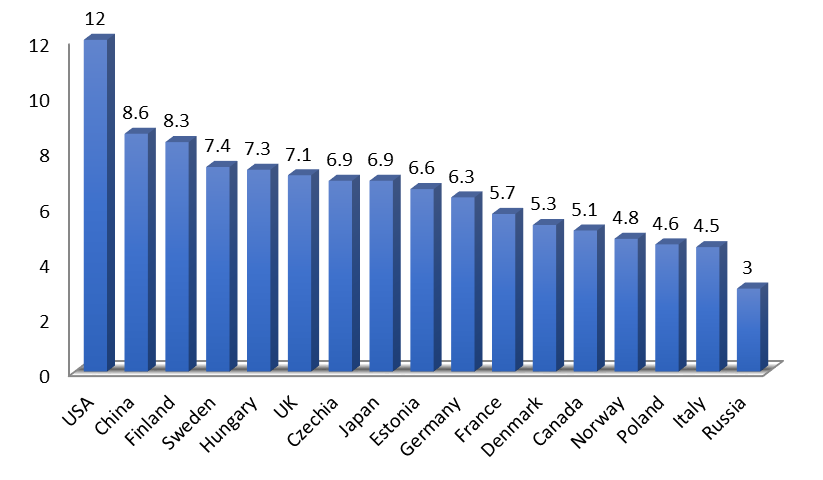
In Russia, this share in 2015 was 5.5%, and in 2020 - already 3.0. 2020 will be the worst year for the world economy in the last century. There has been no such large-scale and global economic downturn since the Great Depression of the 1930s.
According to the results of 2020. the world's global GDP is expected to decline by 4.4%.
According to the IMF, if the vast quarantines on the planet are extended, and the coronavirus returns (even with a lighter epidemic) in 2021, then the overall economic blow will be twice as strong.
Fund experts believe that the Covid-19 crisis will leave long scars in the global economy.
The world leader in the share of the digital economy in GDP is the absolute leaders in the share of digital GDP are the United States with an indicator of 12% and China with an indicator of 8.6%. With a ratio of digital to global GDP, the United States owns 12% of digital GDP and 24% of global GDP, China owns 12% of global GDP. However, this figure is growing at a faster pace than in other countries. The share of France's digital GDP is just over 8%, the share of Germany's digital GDP is just under 8%. The digital GDP of other countries is significantly lower than global GDP.
Also note that just as the economy and society as a whole develop unevenly (Rossijskij statisticheskij ezhegodnik, 2019), their digital transformation also occurs unevenly. Policies, legal norms, traditions and culture, the level of development of economic subsystems achieved, the development of education and its own technological base, as well as many other factors, play a significant role in the formation of a country's digital economy. For example, the digital market of China, the country with the largest number of Internet users in the world (over 720 million people), exists autonomously from the world (Avdeeva et al., 2013).
Research Questions
In course of the study the following questions were raised:
- What is the role of digitalization in the economy?
- What is the importance of economic subsystems in the development of digitalization?
- What is the development of digitalization of the economy for the country in the future?
- How does the development of digitalization have a positive impact on the economy?
Purpose of the Study
Answers to these questions will mark the problems and prospects for the development of digitalization of economic subsystems.
Research Methods
Authors used the universal scientific research methods as well as methods for comparative and statistical analysis.
It should be mentioned that the digital transformation of organizations, both profit and non-profit (including government), is a reaction to the development and active dissemination of new digital information technologies around the world (Minakov et al., 2018). At the same time, based on the paradigm of progress prevailing in science since the Renaissance, it is assumed that the main goal of the development of the digital economy is to improve the life of people, improving the quality of goods and services produced using modern digital technologies, as well as their accessibility.
Effective development of markets in the digital economy is possible only with the availability of advanced technologies, so measures to stimulate it should focus on two areas:
- The first is institutions; their restructuring and modernization are required to create the conditions for the development of the digital economy (regulation of digital markets and digital production, training of personnel with digital competencies, etc.).
- The second is the technical infrastructure (data networks, data centers, software services, etc.), the creation of which requires not only significant efforts, but also investments. It should be noted that, despite the obstacles and difficulties, the digital economy as a whole continues to develop rapidly in the world.
So, for example, in 2015-2019, the Russian Internet trading market grew by an average of 29% per year (Zhukova, 2018). According to estimates of the Internet trading market in Russia in 2019, online sales of consumer goods reached 2.06 trillion rubles, and this sector has become one of the most dynamically developing sectors of the economy (See in Figures 2,3).
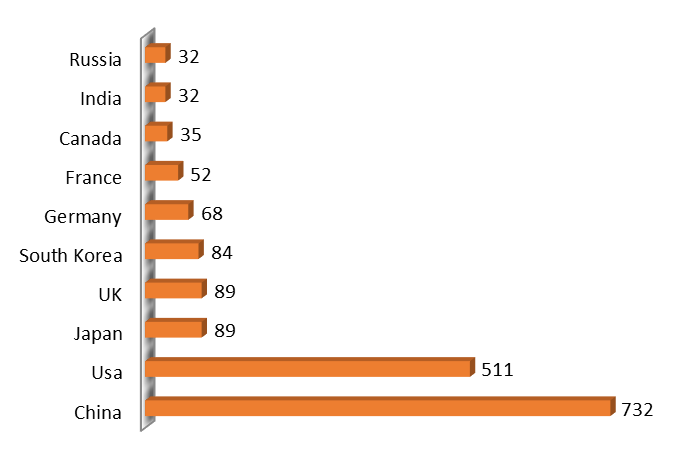
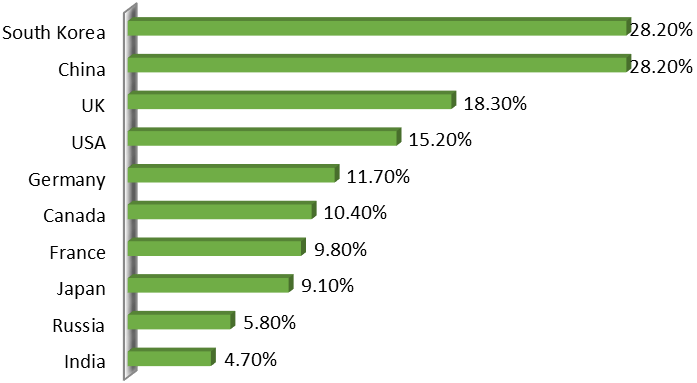
The rapid growth of online sales in 2015 allowed Russia to enter the Top 10 regional Internet trading markets, only slightly inferior to Canada and India. The largest regional markets are China ($732 billion), the United States ($511 billion) and Japan ($89 billion). According to Euromonitor estimates, the global Internet trading market exceeded $2 trillion, an increase of 15.2% over the year.
At the same time, the share of Internet commerce in the total volume of retail trade in the world is gradually growing, it has increased almost 1.5 times (Zhukova, 2018).
The industrial sector of the digital economy is also growing. Industrial automation, big data and artificial intelligence, the use of which became possible thanks to digital technologies, transform industrial processes and models of production and technological cooperation, accelerate and reduce the cost of production of various products, performance of work and provision of services. This opens up new ways of using human potential, but at the same time it can create social problems associated with the obsolescence (primarily in developed countries) of a number of mass, "traditional" professions.
In order to develop the digital economy in Russia, a decree was issued on May 9, 2017 "On the Strategy for the Development of the Information Society in the Russian Federation for 2017-2030," which defined a program of events for the development of the economy in Russia for the medium term, taking into account the possibilities of its informatization and digitalization. In follow-up to this document, on July 28, 2017, an order of the Government of Russia was issued, approving the program "Digital Economy of the Russian Federation."
The main objectives of the program are:
- Creating conditions for the development of high-tech industries and preventing the creation of restrictions in traditional sectors of the economy;
- Increasing the competitiveness of sectors of national economy and strengthening them in the world market.
Note that Russia has good starting positions for the development of the digital economy.
So, for example, according to Rosstat, the Internet audience in Russia at the end of 2019 reached 118 million people (81% of the population aged 12 to 64 years) (Figure 4) (Zhukova, 2018). At the same time, about 60% of the population of the Russian Federation use the Internet, including through mobile devices, and 20% of the country's population use Internet access only from mobile devices. A well-known indicator such as the Network Readiness Index, which is calculated by the World Economic Forum and published in The Global Information Technology Report, also can be mentioned. This Index shows how effectively the world's economies use digital technologies to increase competitiveness, and assesses the factors that influence the development of the digital economy.
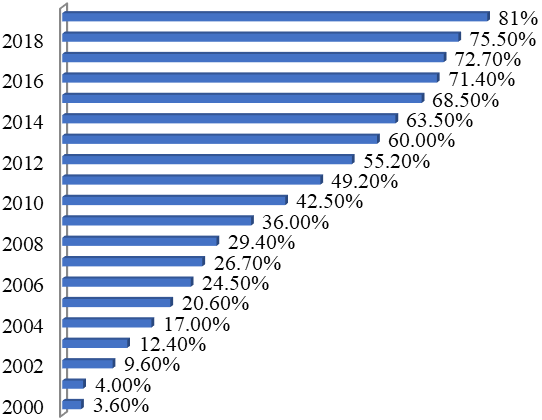
In the last ranking. Russia took 11 position in the world, demonstrating good dynamics. Among other BRICS countries, the places in the ranking (2016) were as follows: China was in 59th place, South Africa - in 65th, Brazil - in 72nd, India - in 91st.
Russia’s position in the ranking of countries in the world by competitiveness for 2019 is given in Table 2.
Thus, on the one hand, Russia has good starting opportunities for the development of the digital economy. On the other hand, being on the top ten world rankings, requires intensified efforts, with a focus on improving the situation. In particular, the concentration of resources in priority areas is required. The main technologies that will be used in the implementation of the adopted program of the digital economy in the Russian Federation are: Big Data (big data); artificial intelligence; wireless communication (country distribution of access to the 5G network); virtual and augmented reality; expansion of Internet distribution (Andreyeva et al., 2018).
In general, the digital economy of Russia has received a significant impetus for development in recent years. Some success has been achieved by private companies, the labor market is being transformed, with the support of the state, unprecedented infrastructure projects are being implemented that increase the level of accessibility of digital services to the population and business, the Internet, mobile and broadband communication have become widespread.
Findings
Risks and threats of the digital economy, ways to overcome risks
It should be noted that, like any other large-scale phenomenon, the development of the digital economy has not only positive consequences, but also various kinds of risks and threats.
Their sources are two main effects. Firstly, this is the emergence of new types of risks and threats inherent in the digital economy and based on its technological characteristics. Secondly, in the transition to a digital economy, there is an institutional transformation, which in itself, regardless of its causes and nature, is a powerful destabilizing factor for sustainable and successful socio-economic development.
Consider some of the negative effects of the digital economy:
The rise of cybercrime. In 2019, more than one and a half thousand attacks; this is 19% more than last year. In 81% of cyber attacks, legal persons were victims. At the end of the year, the five most often attacked industries included government agencies, industry, medicine, the field of science and education, and the financial industry. (Figure 5)
Technological vulnerability of established digital infrastructure;
Rapid obsolescence of equipment and, as a result, the problem of its disposal. If the problem of nuclear waste management is the focus of public attention and rather serious legislative regulation, the problem of "electronic waste" management is rarely raised [9]. Meanwhile, according to the UN, up to 100 million tons of "electronic waste" are produced every year in the world, no more than 20% of this volume is processed in accordance with environmental requirements. With the development of the digital economy, its environmental dangerous effects will increase;
Increasing technological dependence on foreign suppliers and, as a result, weakening technological and economic security at the level of the country as a whole, as well as individual industries and enterprises. A serious deterrent to the development of the digital economy is the personnel restrictions in the Russian Federation. So, according to the Foundation for the Development of Internet Initiatives, by 2027 the Russian economy will suffer a shortage of about 2 million IT specialists.
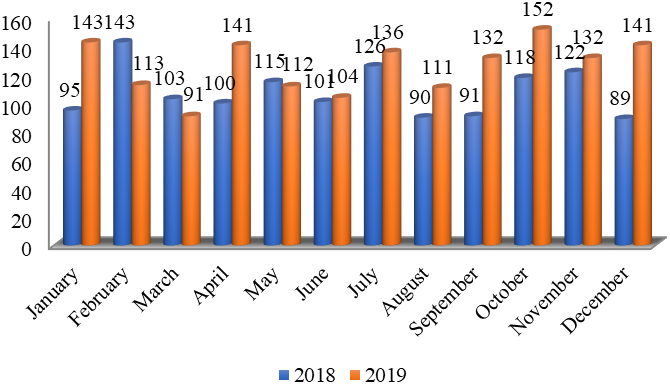
Challenges for the development of digitalization of economic subsystems
Among the priorities that determine the areas of activity, in our opinion, we can indicate:
Stimulating the creation and development of a business focused on the digital economy. Today in Russia already there are companies that can be recognized as world leaders in segments of the digital economy (Kaspersky Lab, ABBYY, Parallels, Luxoft, Yandex, etc.). The state can provide them with targeted support: provide guarantees for bank loans, including export loans, compensate for part of the costs of patenting, form targeted investment funds, provide support through the public procurement mechanism, etc.;
Additional support for small and medium-sized businesses in the field of creating digital technologies, platforms, and the provision of digital services. This can be done, for example, by providing certain incentives to the companies concerned (for example, insurance payments or tax premiums) developing digital technologies, creating healthy competition between such companies, providing them with orders and standards to which the final product should conform;
The formation and scaling of digital platforms for the main sectors of the economy. Now in Russia and many other countries there are portals for the provision of state and municipal services, platforms for making payments, tax authorities are switching to accepting electronic reporting, plastic cards are being introduced for social payments, etc. It should be noted that in Russia there are significant problems associated with the introduction of IT in local governments.
Increased training of IT specialists;
the formation of sectoral, regional and country-wide cybersecurity systems. In particular, it is necessary to finalize legislation on combating cybercrime, create protection units in law enforcement agencies, develop protected technological solutions, and ensure interaction between all participants in the global digital economy. At the same time, it should be remembered that ensuring safety should not hinder the growth and development of technology. International information exchange on cybersecurity should be strengthened (Andreyeva et al., 2018).
Conclusion
The digital economy is a new type of economic relations, which is already present in all sectors of the world market and is actively developing. The digital economy may soon become a leading segment, a driver of growth and development of the economic subsystems. Due to the fact that the digital economy has some advantages over material cash exchanges, such as the speed of delivery of goods or the almost instant provision of services. Another advantage of the digital economy is the lower cost of production and transaction execution. One of the key advantages of the digital economy over the traditional one is that electronic goods are practically inexhaustible and exist in non-material form, but material ones are almost always limited in quantity and access to them is much more difficult. Today, the electronic economy is already going beyond purely economic processes. Digitalization is being introduced into social processes, the success of people is increasingly dependent on it, in addition, there is a large-scale introduction of digital technologies into the work of government organizations and structures. Efforts to digitalize Russia are based on the Strategy for the Development of the Information Society and the provisions of the state program "Digital Economy." In these documents, the purpose and main mechanisms for implementing the digital transformation of the Russian economy were carried out, as well as the sources and volumes of financing for the events determined. If we consider the situation as a whole, then in terms of the level of development of the digital economy, Russia does not occupy a leading position, but confidently holds in the group of countries following the leaders, improving positions year after year. At the same time, competition in the area under consideration remains very tough, therefore, it is impossible to rely on what has been achieved, joint work of the state and business is necessary to further develop the digital economy. A number of issues, risks and threats identified in the article should be taken into account in order to focus resources and efforts on their neutralization.
References
Alexandrova, А. V., Aletdinova, А. А., Aftahova, U. B., Babykin, А. V., Bachurina, S. S., Bogachkova, L. Yu., Borisov, А. А., Bulatova, N. N., Vasilenko, N. V., Vakhitova, L. R., Vladimirova, I. L., Volkova, А. А., Gamidullaeva, L. A., Goldenova, V. S., Grigorieva, E. A., Guskova, N. D., Kallaur, G. Yu., Kovrov, G. S., Kozlov, A. V., Konshina, A. O., Krasnyuk, L. V., Krasnyuk, L. V..., & Yashin, S. N. (2018). Formation of digital economy and industry: new calls. Peter the Great St. Petersburg Polytechnic University.
Andreyeva, G. N., Badalyants, S. V., Bogatyreva, T. G., Borodai, V. A., Dudkina, O. V., Zubarev, A. E., Kazmina, L. N., Minasyan, L. A., Mironov, L. V., Strizhov, S. A., & Sher, M. L. (2018). Development of digital economy in Russia as a key factor of economic growth and improvement of quality of life of the population. Professional science.
Avdeeva, I. L., Akchurina, I. G., Alekhina, E. S., Beklemeshev, V. P., Bratukhina, E. A., Bykova, E. A., Vasukova, L. I., Vertakova, Yu. V., Glukhikh,m L. V., Gusaruk, M. A., Davydova, M. V., Ignatova, O. M., Kashirtseva, A. YU., Klevtsova, M. G., Korolchenko, O. E., Kulikova, Yu. A., Lisovskaya, R. N., Miroshnichenko, O. S., Mishchenko, A. N., Nozdrina, N. A., Ogareva, Yu. A., Pozdnyakova, T. V., Polozhentseva, Yu. S., Rybyantseva, M. S., Sigidova, M. Yu., Sitnikova, E. V., Tatarnikova, N. V., Tolmachev, A. B., Tubalets, A. A., Fesenko, E. V., Charochkina, E. Yu., Shamrova, K. N., and Shamrov, K. N. (2013). Economy of regions: development trends: monograph. VSPU publishing house.
Bodrunov, S. D., Demidenko, D. S., & Plotnikov, V. A. (2018). Reindustrialization and formation of “digital economy”: harmonization of trends through process of innovative development. Administrative consulting, 2(110), 43-54.
Ivanovskaya, L. V. (2019). Digitalization or digital economy: problems and perspectives. Vestnik universiteta, 1(6), 45-50.
Kurbanov, A. H., & Kurbanov, T. H. (2018). Use of modern digital technologies in logistics. Development of regional economy in the conditions of digitalization. The collection of materials of the International scientific and practical conference devoted to 80th anniversary of the Chechen State University, 683-688.
Minakov, V. F., Shuvayev, A. V., & Lobanov, O. S. (2018). Effect of digital convergence in economy. News of the St. Petersburg State University of Economics [Izvestiya Sankt-Peterburgskogo gosudarstvennogo ekonomicheskogo universiteta], 2(110), 12-18.
Prokopyeva, T. V., Prokopyev, A. V., & Popova, A. Yu. (2018). Digital economy - a prospection. Open innovation. Collection of Articles of the Vth International scientific and practical conference, 97-101.
Pshenichnikov, V. V. (2018). Prospects and risks of application of electronic money in the conditions of digitalization of economy. News of the St. Petersburg State University of Economics [Izvestiya Sankt-Peterburgskogo gosudarstvennogo ekonomicheskogo universiteta], 1(109), 39-45.
Rossijskij statisticheskij ezhegodnik. (2019). Federal’naja sluzhba gosudarstvennoj statistiki (Rosstat). Moscow.
Vertakova, Yu. V., Tolstykh, T. O., Shkarupeta, E. V., & Dmitrieva, V. V. (2017). Transformation of administrative systems as a result of digitalization of economy: monograph. SWSU publishing house.
Zhukova, V. I. (2018). Digital economy in russia: development trends. Сolloquium-journal, 10(21), 58-59.
Copyright information

This work is licensed under a Creative Commons Attribution-NonCommercial-NoDerivatives 4.0 International License.
About this article
Publication Date
25 September 2021
Article Doi
eBook ISBN
978-1-80296-115-7
Publisher
European Publisher
Volume
116
Print ISBN (optional)
-
Edition Number
1st Edition
Pages
1-2895
Subjects
Economics, social trends, sustainability, modern society, behavioural sciences, education
Cite this article as:
Armashova-Telnik, G. S., Zubkova, A. N., Sokolova, P. N., & Sokolova, O. (2021). Digitalization Of The Economy: Multi-Criterion Subsystem Optimization. In I. V. Kovalev, A. A. Voroshilova, & A. S. Budagov (Eds.), Economic and Social Trends for Sustainability of Modern Society (ICEST-II 2021), vol 116. European Proceedings of Social and Behavioural Sciences (pp. 1672-1683). European Publisher. https://doi.org/10.15405/epsbs.2021.09.02.187

